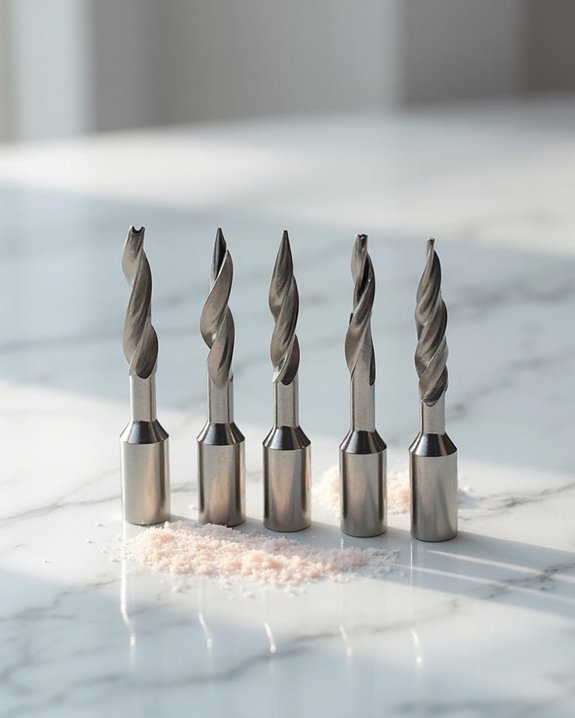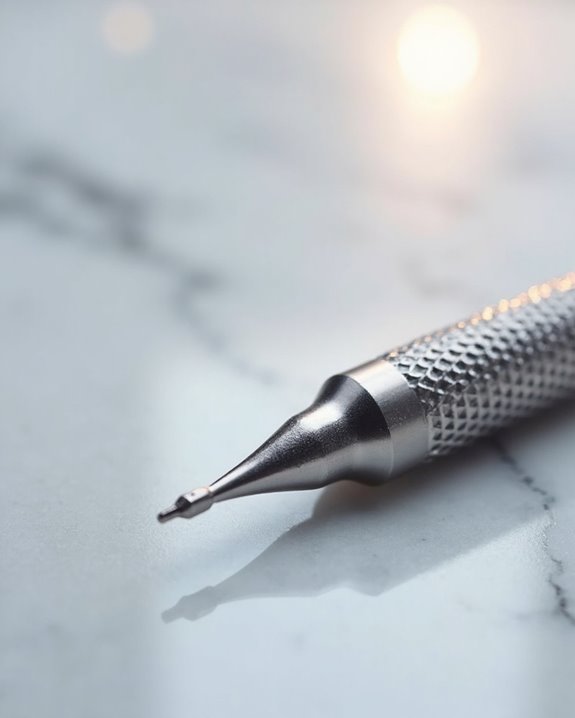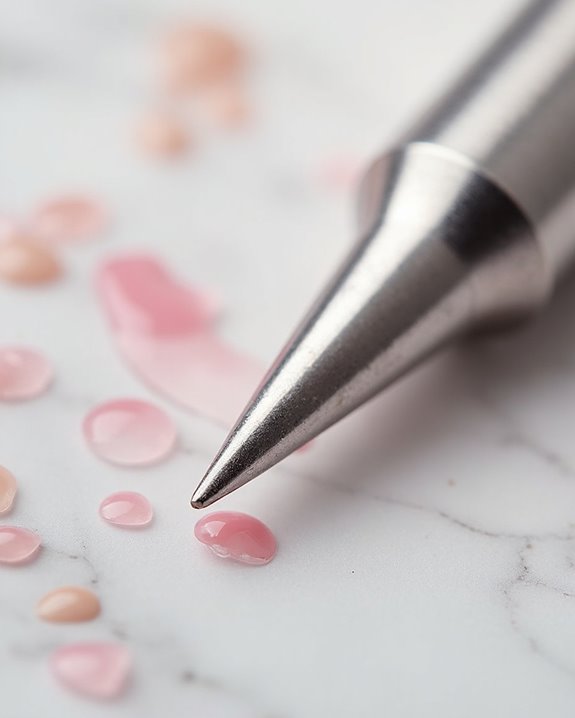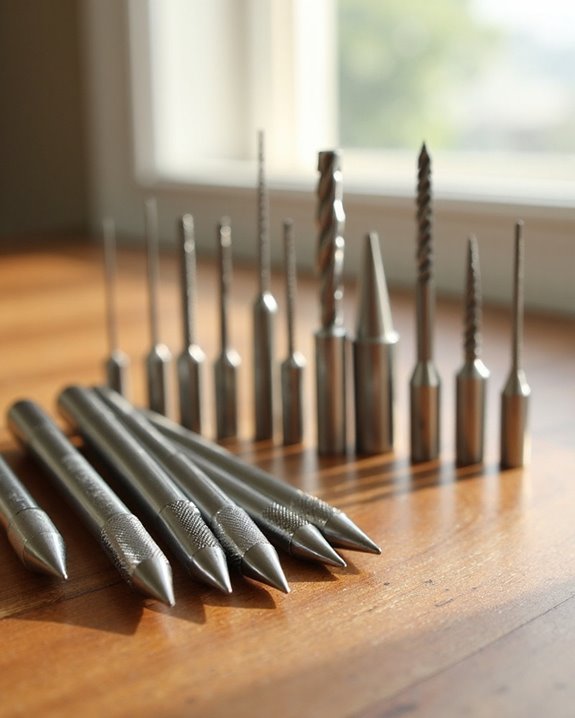The best nail drill bits for acrylics include carbide bits with rounded heads for efficient removal while protecting natural nails, safety bits with cone shapes for beginners, and diamond bits for professionals seeking faster results. Tungsten carbide options offer superior durability, while medium-grit bits provide balanced removal without excessive force. Operating at lower speeds prevents overheating and damage to nail beds. Proper bit selection combines effective acrylic breakdown with natural nail protection, ensuring both safety and efficiency during the removal process.
Key Takeaways
- Tungsten carbide bits with rounded heads efficiently remove acrylic while protecting natural nails underneath.
- Medium-grit safety bits provide beginners with controlled removal capability without risking nail bed damage.
- Diamond bits offer fastest removal for professionals but require advanced skill to prevent overheating and nail damage.
- Operate drill bits at lower speeds with gentle pressure to prevent thermal damage during acrylic removal.
- Choose cone-shaped or barrel-shaped bits for precise control when working near cuticles and sensitive nail areas.
Understanding Carbide Bits for Effective Acrylic Breakdown
Why do professional nail technicians consistently choose carbide bits for acrylic removal? The answer lies in their unique design and efficiency. Carbide bits feature a coarse grit structure that effectively breaks through acrylic material, allowing technicians to remove product without applying excessive force. The rounded heads on these specialized bits provide critical protection for the natural nail beneath, greatly reducing damage risk during the removal process.
These bits eliminate time-consuming buffing sessions by directly tackling acrylic layers, though they require slow, controlled application to prevent overheating. Professional-grade options like the Typhoon Medium bit ($8.79) and Safety Removal Bit – Medium ($11.99) maintain exceptional ratings of 4.9/5 stars, confirming their reliability. For best results, technicians apply gentle, steady pressure with carbide bits to methodically break down acrylics while avoiding common complications like cracking. Furthermore, opting for bits made from tungsten carbide ensures superior durability and long-lasting sharpness through multiple sessions.
Safety-First Drill Bits for Beginners
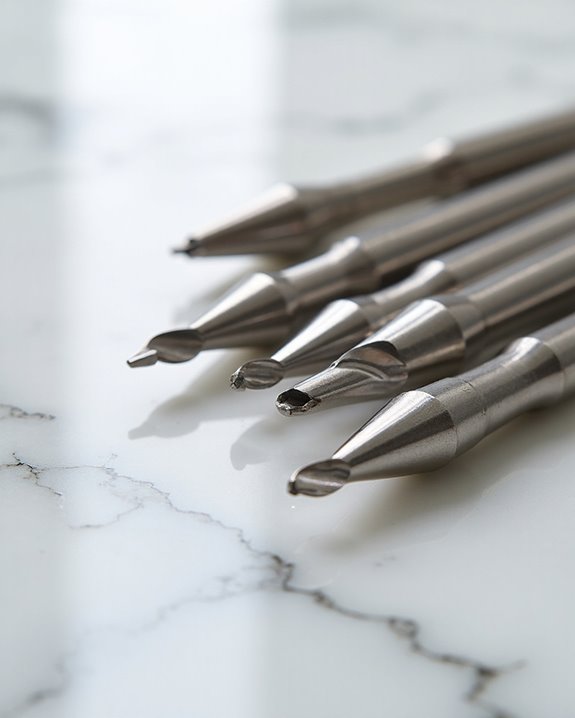
While carbide bits excel in professional hands, beginners require specialized tools that prioritize nail protection as they build confidence. Safety bits featuring cone-shaped tips provide precise control during acrylic refinement, preventing accidental penetration into natural nails beneath.
The Safety Removal Bit in medium grit ($11.99, 4.9/5 rating) offers effective acrylic demolition without requiring excessive force, making it ideal for novices learning to remove acrylics without causing damage. For detailed work, the fine-grit safety bit ($11.99, 4.2/5 rating) allows gentle shaping and thinning of acrylics while maintaining nail integrity. These specialized nail drill bits emphasize minimal pressure application, which prevents overheating and protects underlying nail beds.
Beginners benefit most from bits that encourage a slow, methodical approach, eliminating extended buffing while focusing on controlled removal that preserves natural nail health throughout the process. To achieve professional results at home, beginners can opt for bits with tungsten carbide construction, which provides longevity and precision without compromising safety.
Diamond Bits: Pros and Cons for Advanced Users
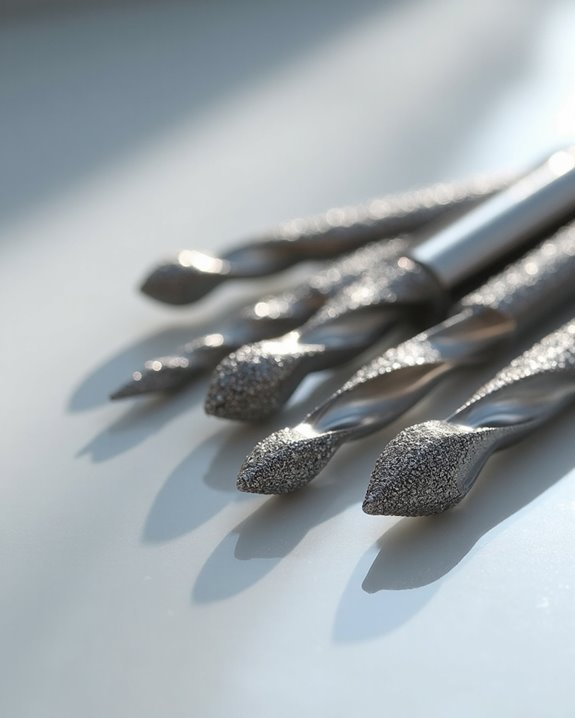
Advanced nail technicians frequently turn to diamond bits as their premium choice for acrylic nail procedures, given these bits’ exceptional durability and superior cutting efficiency. These specialized tools excel at rapidly penetrating acrylic materials, greatly reducing removal time for professionals managing multiple clients throughout their day.
Despite their effectiveness, diamond bits require careful handling to prevent potential damage to natural nails. Their aggressive cutting action, while efficient, can lead to thinning or cracking of the nail plate if excessive pressure is applied. Proper heat dissipation remains critical when working with these bits, as their high-friction design generates temperature increases that could harm the nail bed. Technicians must operate at lower speeds, implementing techniques that minimize heat buildup while maintaining control. For these reasons, diamond bits remain unsuitable for beginners working with acrylic nails.
While diamond bits provide robust performance, ceramic bits offer a safer alternative by reducing heat generation during use.
How to Prevent Overheating During Acrylic Removal
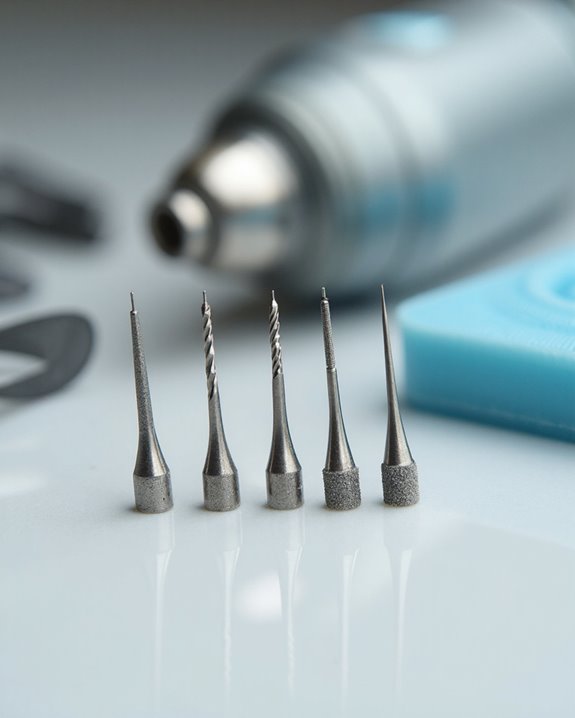
Heat management presents one of the most significant challenges when removing acrylic enhancements, requiring specific techniques to protect both the natural nail and the client’s comfort. Selecting drill bits with built-in cooling features, particularly those made of aluminum alloy, effectively dissipates heat during extended sessions, ensuring low vibration while maintaining control. Technicians should operate carbide nail bits at reduced speeds, applying gentle, steady pressure to methodically break down acrylic layers without generating excessive heat.
Safety bits with cone-shaped tips offer ideal protection when used with minimal pressure, allowing for precise refinement of surfaces without thermal damage. Contrary to common practice, high speed settings should be avoided, particularly with diamond bits which rapidly generate heat and potentially cause structural damage. A deliberate, unhurried approach consistently delivers safer results, preserving natural nail integrity throughout the removal process.
The Best Drill Bit Shapes for Protecting Natural Nails
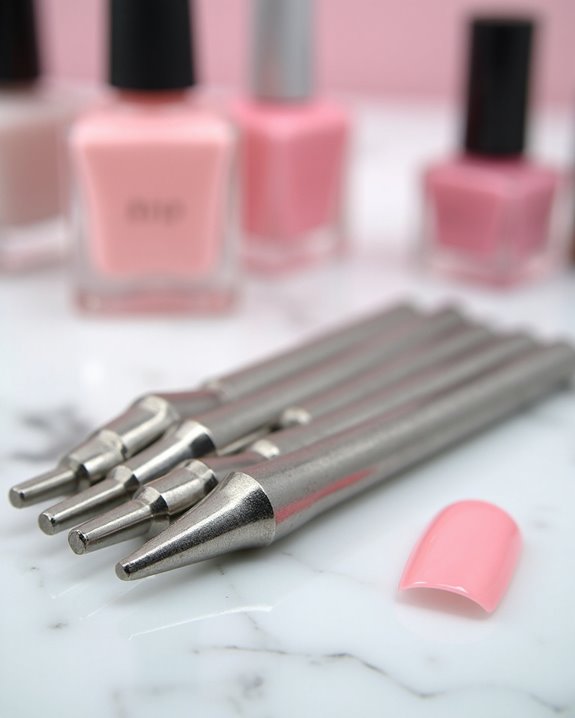
Selecting the ideal drill bit shape represents a crucial decision when working with acrylic enhancements, determining both the safety and final quality of the nail service. Carbide bits with rounded heads provide exceptional protection for natural nails by minimizing direct contact during removal, creating an essential barrier against damage. Cone-shaped safety bits offer precise control when thinning acrylic layers, preventing accidental drilling with minimal pressure.
For the sensitive cuticle area, barrel-shaped bits like the Mini Barrel Diamond Medium (rated 4.8/5) deliver targeted precision. Flame-shaped nail bits, such as the highly-rated Flame Coarse (4.9/5), distribute pressure evenly during detailed removal. The Tapered Barrel Medium (4.9/5) enables controlled, gradual material reduction, safeguarding natural nails against excessive heat and structural damage while maintaining integrity.
Comparing Coarse vs. Fine Grit Options for Acrylic Removal
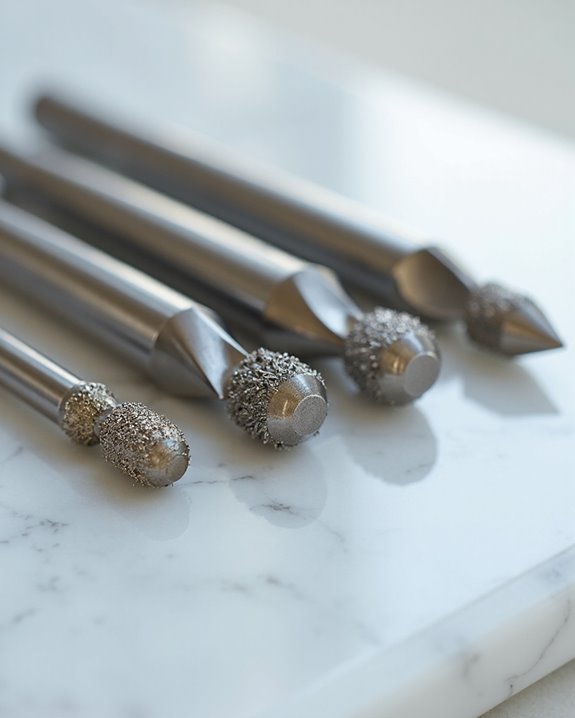
Once the proper bit shape has been determined for acrylic nail work, the grit factor becomes the next important consideration for technicians seeking best results. Coarse grit options, like the highly-rated XL 5-in-1 Coarse ($15.99) and the economical 50 Ct. Small Sanding Bands ($6.39), excel at efficiently breaking through acrylic layers with their aggressive texture, greatly reducing removal time in professional settings.
In contrast, fine grit alternatives, such as the XL 5-in-1 Fine and the Safety Removal Bit, provide gentler refinement with minimal heat buildup, making them ideal choices for beginners or precise detail work. The Best Nail Drill setups typically incorporate both varieties, allowing technicians to begin with coarse sanding bands for demolition before switching to fine grit for finishing touches, ensuring natural nail protection through controlled, gradual material removal.
Essential Techniques for Minimizing Pressure and Damage
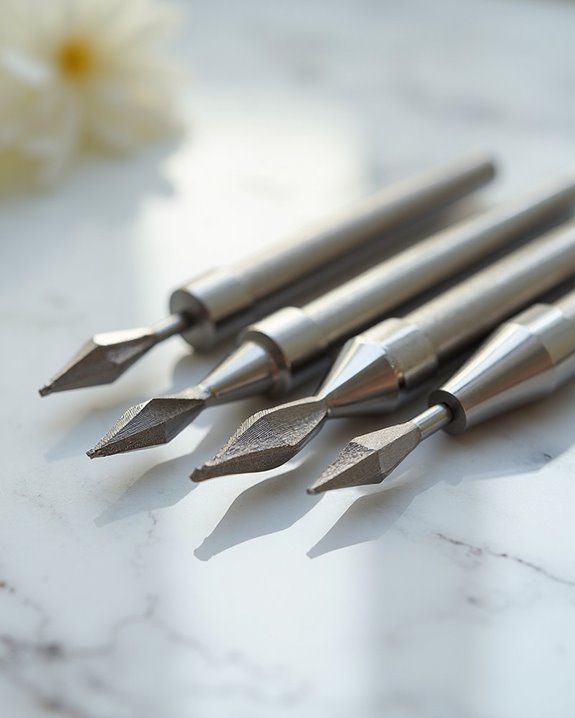
The cornerstone of successful acrylic manipulation lies in the technician’s ability to apply minimal pressure during the removal process, creating a delicate balance between efficiency and protection of the natural nail bed. Experts emphasize that selecting the right bit for the job greatly reduces the risk of damage to the nail, with cone-shaped safety bits enabling precise refinement when used with gentle pressure. Pick the right carbide bits for breaking through acrylic layers safely, maintaining a slow, steady approach rather than applying excessive force. This methodical technique eliminates extended buffing sessions while preventing overheating of the nail plate. The combination of appropriate bits and controlled pressure creates ideal conditions for acrylic removal, preserving nail integrity through precision movements that prioritize protection over speed.
Frequently Asked Questions
What Nail Drill Bit Is Best for Removing Acrylics?
Coarse carbide bits are ideal for acrylic removal. Bit Innovations like the XL 5-in-1 Coarse bit receive exceptional user feedback (4.9/5 from 723 reviews). Cost factors remain reasonable at $15.99 for professional-grade performance.
What Drill Bit Is Best for Acrylic?
While different tools serve various purposes, carbide bits offer superior acrylic shaping capabilities with excellent bit durability. Professionals often prefer the XL 5-in-1 Coarse bit for design techniques that require efficiency and precision.
How to Take Acrylics off With a Nail Drill?
Removing acrylics requires proper technique tips: use coarse carbide bits with minimal pressure, maintain low speed adjustment (under 20,000 RPM), and practice regular drill maintenance to prevent overheating during the slow, controlled removal process.
What Are Safety Nail Bits?
With 94% of nail technicians prioritizing product safety, safety nail bits feature cone-shaped designs that prevent nail bed damage. Proper user training and regular bit maintenance guarantee best performance while protecting natural nails during acrylic work.

